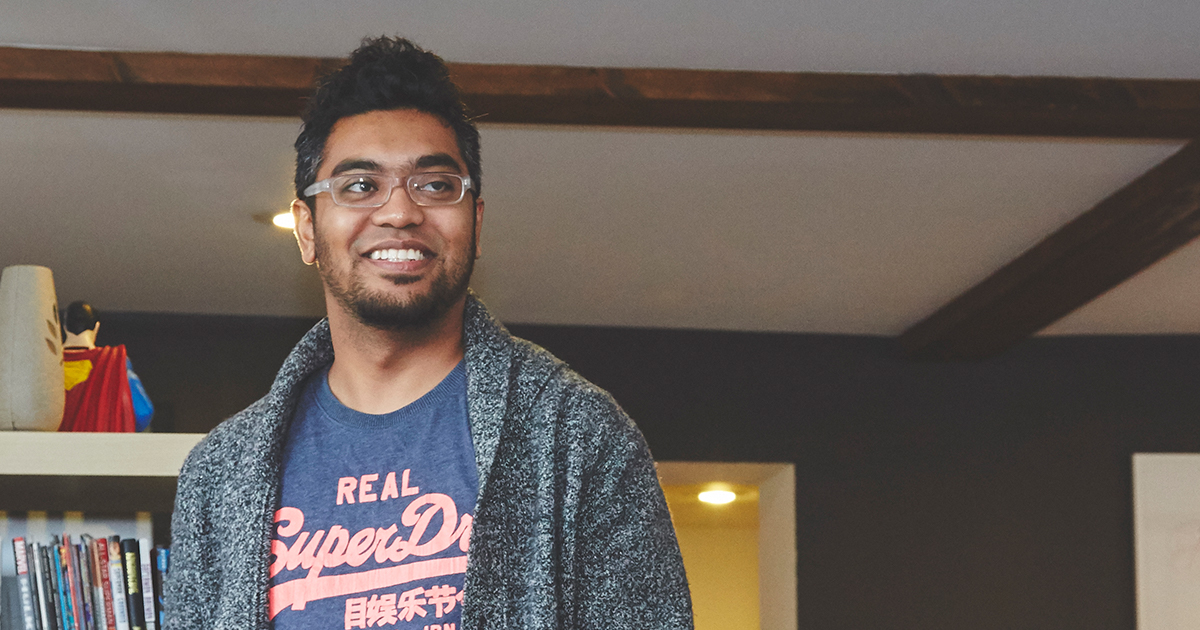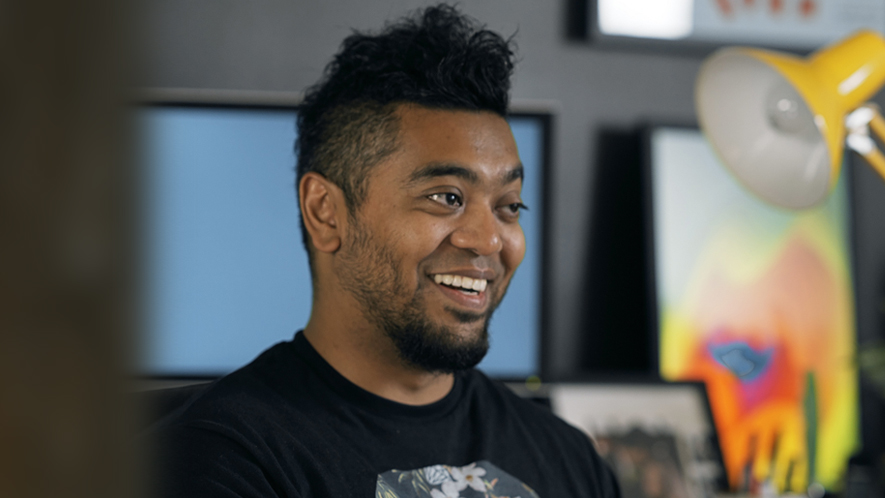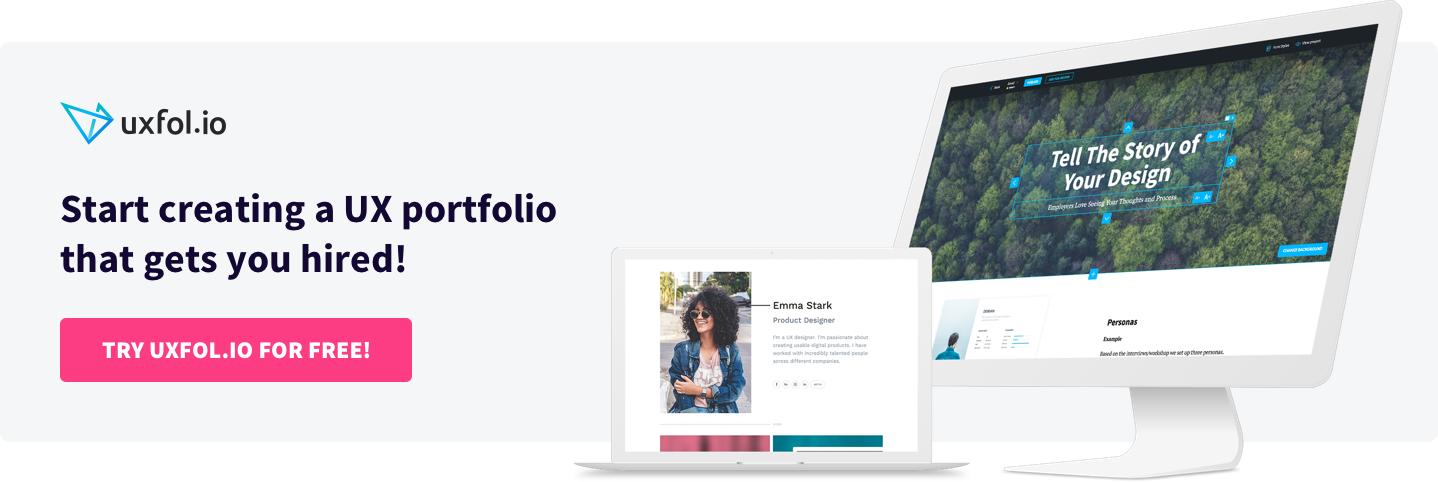I talked with the well-known Philadelphia designer, SuperFriendly Collective and SuperBooked CEO Dan Mall. A designer for 20 years now, he also has a popular design blog. We talked about one of the fears designers have when they search for a job, how to overcome it and how to build a portfolio that stands out from the crowd.

Hi Dan! So good to have you here on our blog. Can you tell us about yourself and the consultancy company you run?
Sure. I’m a creative director, and I grew up as a designer. I went to school for design. I’ve run design teams, developer teams and interactive teams before. And now, I’ve been running my own for the past seven years. I run a consultancy called SuperFriendly. So the work that we do for clients is generally working with in-house teams to help them to kind of jump-start exciting projects that they are doing.
I read your blog post about design portfolios. I’m really curious, what was the motive behind it? Why did you write it?
I run an apprenticeship program as part of SuperFriendly, usually for people who are career switchers. I work with people who have very little or maybe no experience in design or development. Because I don’t hire anybody full-time, they don’t expect to work here at the end of their apprenticeship. I help them put together resumes and portfolios, and help them with job interviews so that they can go apply somewhere else and get a job somewhere else.
So we are talking a lot about portfolios, like what hiring managers want to see in their portfolios. We also talk to hiring managers to get to know what they want to see. So it’s a common topic around the studio here and I decided to write it down. The intention is to help people make better portfolios and also, to help hiring managers to better expose their criteria so they get better candidates. You know, if people who are hiring have better candidates, and if candidates are making better applications, everybody wins in that scenario.
Yes, that’s true. So what makes a good portfolio?
I think there are a couple of things that make a good portfolio. The first thing is that you should show why you are a better candidate than anybody else, right? You should show why you are a really good fit for the job that the company is offering.
I think what hiring managers want to see is that they want to know you already have the skills you need to do the job they are hiring for.
“I think that a portfolio should basically say that in a nutshell: why you are a really good fit for this position and why they can’t live without you.”
Maybe if you don’t have the skills, there is only a short distance for you to learn those UX designer skills. Some hiring managers have some tolerance for, “All right, maybe you don’t know this technology right now or you don’t have this design skill or this design tool, but in two months you will be able to learn it.” This tolerance changes from place to place. So I think that a portfolio should basically say that in a nutshell: why you are a really good fit for this position and why they can’t live without you.
Okay, let’s say that I’m applying for a job and I really think that I’m a good fit. How can I showcase that in a UX portfolio?
I think a lot about the design process. And one of the first places we always start is the job the product has to do. So maybe this app has to make people buy something. Or maybe this site needs to make people take some action like click next or sign up for something. So there are some tasks that need to be done. Some objectives that need to be accomplished.
And a portfolio is the same thing: it has a job to do. What is its job? To get you a job! So the more you understand that, the better you can design your portfolio. So you need to understand what job you are applying for, what’s the criteria for the job, what is the hiring manager looking for that job, and craft your portfolio towards that. I’m not saying that everybody should do that, but it increases your odds to get the job you want.
One question came up when I was reading your article, because you propose that designers should create a unique portfolio for every job they apply for. But you know, it takes a lot of time. So even creating one of those is quite time-consuming. And let’s be honest with each other, usually a candidate applies for not just one position. So do you think is realistic that candidates will create a unique portfolio for every single application?
I don’t think it’s realistic that every candidate to be able to do that. So certainly what I’m not suggesting is everybody should do this, and that this is what every hiring manager expects. I think that some people can do this and some people can’t do this. And some people are willing to make the investment and are able, and some people are willing to make that investment and are not able.
If everyone could make a custom portfolio for every job they apply to, that would be wonderful. But that’s not the reality of the world. What I mean to say by all this is that if you are applying for a job, you are asking for someone to pay you a lot of money to do a thing, right? So you put something together in a weekend to ask somebody to pay you tens of thousands of dollars over the year to do that thing. It’s hard to put just a little bit in and expect a really big return. If you put a bigger amount in, you can expect a bigger return.
This is simply a good option to increase your odds.
When you see a portfolio yourself, what are you looking for?
Well, it depends on what the portfolio is for, right? Very rarely am I saying: I need a designer, and then that’s it. It’s too general. A designer for what? A designer for an app build or a service design?
When I talk to designers, I try to talk to them and meet before I have a need for their particular skill set. So this morning I just talked to a designer about what she’s interested in doing and what her skills are. So that when I have a project like that, I will feel, “Oh, that’s a good match!” And I wished that more companies did that too. So actually, interview designers in advance. That would make the hiring process a lot smoother, but also takes a lot of investment on the company’s side.
So, for me when I’m looking for a designer generally, the first thing I look at is: “What is the thing you are into? What is your thing?”
And designers are often like, “My thing is to design clean interfaces”. It’s not specific enough. It’s not until we get to the point, “I like designing things that are really bright”. That means if I need a dark, cool interface, maybe you’re not the person. And I think a lot of designers get scared off by that idea. They want to be able to design anything so they are not discounted from opportunities. But I find the opposite is true.
When I know what a designer is specifically good at, that makes me more confident in hiring them for something, than if they’re just like, “Oh, I can do anything”. Then I don’t know and can’t hire you for what you’re doing really well. So I tend to look for what do you well and what do you do poorly. So I avoid to send stuff to you that you would do poorly, but send you the ones you would really excell on.
So maybe it’s a great advice for designers to talk about their favorite topic or the things they are really into in their portfolios.
Absolutely.

Do you remember any specific example of a really good UX designer portfolio you saw?
I had one sample in the article we talked about. It’s a site Francine Tamakloe built for a job at Spotify. It was more like a cover letter. A good portfolio is usually some combination of cover letter, portfolio, resume. The best word I could find for it after talking to many people is a proposal.
So she wrote basically a proposal to Spotify and it looked like Spotify, her words were like Spotify would write them, her work experience was framed via music. It just felt like she already worked there. I think that has a great takeaway. When you look at a portfolio and it’s like: “It’s almost like you work here already”. And yeah, she got a job at Spotify!
I’m sure she did other things like interviews too, but I don’t think that portfolio hurt. It’s a great example of creating alignment between you and the company you want to work for, saying, “Look, I can already do this job and look how well I already do it”.
Sometimes putting together a portfolio is the best exercise to prepare for the interviews, right?
“Sometimes to design the portfolio is a good example of what you’ve been doing most recently.”
Yes, exactly. Because sometimes it’s your most modern piece of work. Your portfolio is your past work. Lots of designers have portfolio pieces that are like two years old, because that’s what they worked on before. So sometimes to design the portfolio is a good example of what you’ve been doing most recently. And a lot of people don’t see that as an opportunity.
And I’d like to ask about the other side of this question. Have you seen very bad portfolios? And I don’t want to name anyone, but maybe to tell a few mistakes that designers should avoid.
“When I see a portfolio of which I don’t really get a sense of who you are, what you’ve done and what you’re good at, what you’re bad at, it’s just not memorable enough.”
I actually don’t know if I’ve seen very bad portfolios. What I have seen is very generic portfolios. Maybe that’s my equivalent of that. I can’t tell the difference between you and somebody else unless your work is just that strikingly good. When I see a portfolio of which I don’t really get a sense of who you are, what you’ve done and what you’re good at, what you’re bad at, it’s just not memorable enough. And there’s no alignment created there, because I’m not sure what I would hire you for. I’ve seen hundreds of portfolios like, “Hi, I’m XY. I’m a digital designer and I love creating digital experiences”. Yeah, you and everybody else. And then I’m like, “OK, if you are like everybody else then I can treat you like everybody else that applied to this job.”
So what I think is that good portfolios should distinguish you. Good portfolios separate you from everybody else. And those are memorable.
I think a lot of people might be afraid to show off their personalities. Do you have any advice on how to stand out?
I’m glad you bring that up, it’s such an important point. I think most of the time people don’t stand out because they’re scared to. There’s a lot of fear. For example, if you share with me that you do really good app design, then you might be scared of that I might not hire you for a website redesign. You’re scared you’re gonna get passed over for that website redesign.
But actually this is what makes work shine and makes me want to work with people is that they can take a stand, they are confident. As designers, part of our job is to help our clients or companies to take a stand. And if we can’t do that on our own, how will we help our companies distinguish themselves? If we can’t even say what we do and what we don’t do, how are we gonna do a good job for the people that are hiring us?
And so in terms of tips and tricks on how to distinguish yourself? I find it very difficult to say on my own, “Here’s what I do well and here’s what I do poorly.” It’s tough because I’m really biased. And there are always reasons that I don’t want to say good things about myself. So what’s easier to do is to ask a really good friend, “Hey, can you tell me some nice things about me?” It’s a little bit awkward, but getting somebody else to say, “You know what, here’s what you’re really good at,” helps a lot, so you just write those things down. So don’t try to do it yourself. Ask your friends or ask your clients. What would your last client that you loved working with say? “Jane did such a great job on that project, she sketched the whole time and the level of polish in her work was unparalleled, something that we’ve never seen before.” Awesome, put that on the top of your portfolio! The level of polish is unparalleled. That’s the thing that distinguishes you. Of course, your work has to support that.
That’s a great tip. You know, we are building this platform, UXfolio. And what we see is that there are two distinct groups of users. We have many juniors who are ready to start their UX careers and we also have some seniors who want to stand out from the crowd of the juniors. So my last two questions would be about them.
If someone doesn’t have much experience yet, what would you advise them, to get into the design industry? And on the other side, how do you think seniors can stand out with their experience and their senior UX designer portfolios?
I think it’s close to what we’ve been talking about before: put something in your portfolio others don’t have.
“What people put in their portfolios generally are screenshots of the final work. Everybody does that.”
If you are very senior but all you have to put in your portfolio is some nice UIs that you did — well, maybe you’re not that senior. The things that distinguish seniors from juniors are rarely in the UI. Instead it’s more like, “Oh, I had a conversation with the client about my work”. Put the script or an audio recording of that in your portfolio. Put a picture of the whiteboard sketch that you did to unlock that new insight in that meeting or explain how you convinced the client about something — whatever others usually don’t put in.
What people put in their portfolios generally are screenshots of the final work. Everybody does that. There is a great quote by Seth Godin in one of his books. He says, “The thing that makes a museum is the stuff that’s not on the walls.” So if you are a cubist museum, you are not a cubist museum just because you have cubist art on the wall but because you don’t have postmodern or renaissance art on the wall. That’s just as important.
So when I’m talking to both junior and senior designers, I want to know what you do that nobody else does. That’s the toughest question. If there’s nothing you’re doing that other people are doing, that’s the thing to work on before putting a portfolio together. So I often try to focus on what is your special skill set. What are your superpowers? Are you funny? Make your portfolio funny. Then at least you are a designer who is funny, not just a designer. Show us who you are. Are you an athlete? Do you collect stamps? So many things are alignment building. If you collect stamps and the person interviewing you collects stamps, you’re gonna have a deeper connection than if they didn’t know that about you. It’s good for both juniors and seniors.
Another thing for juniors is that sometimes they reach too high and it’s hard to be realistic. Let’s say I’m a junior UX or website designer. I just graduated from this bootcamp, I have twelve weeks of experience, and I want a hundred-thousand-dollar job. You probably won’t get that and you will get a lot of disappointment with your portfolio. So having realistic expectations on what you’re doing, what your skill set is and what job you’re reaching for is helpful.
Staying with the previous example, you could probably get an internship really easily, but you won’t get a senior designer job. And I know it’s hard for juniors to assess that. The Dunning-Kruger effect shows how, as a junior, you don’t even know how junior you are because you are a junior. It’s good to have other peers to have a look at your work and be objective about it. So they can say, “Listen, I think you are overshooting”, or the opposite: “You should absolutely shoot for that position”. Search for people that can be honest for you, good mentors, good peers, good colleagues, good coworkers. Feedback is invaluable. Sometimes it’s hard to find but if you do find, make use of those.
Great. You gave really helpful advice for all the designers out there. Thank you so much for the interview and for all the great UX portfolio tips, Dan. It was a pleasure to talk to you.

In case you want to stand-out from the crowd with your UX portfolio as Dan advised, UXfolio is a good platform for it. You can easily create meaningful portfolios: even different ones for all the different jobs you are applying for. Also, you can ask for reviews, given by UX experts and the UXfolio community to get the most out of your portfolio.
Start building your outstanding UX portfolio today: Click here to sign up and try it out UXfolio!
